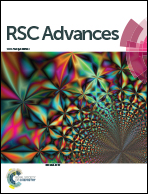Experimental and theoretical studies of adsorption of ibuprofen on raw and two chemically modified activated carbons: new physicochemical interpretations
Abstract
Knowledge of the ibuprofen (IBP) adsorption isotherms is important to understand and to improve its depollution process. In this work, the double layer model with two energies was applied to simulate the adsorption isotherms of ibuprofen on raw activated and two chemically modified granular activated carbons, obtained experimentally at pH = 7 and at different temperatures (298, 313 and 323 K). The chemically modified samples were obtained by treatment at 700 °C under nitrogen flow and ultrasonic treatment in H2O2 solution of the raw granulated activated carbon. The establishment of the model is based on a statistical physics approach, particularly on the grand canonical ensemble. The double layer model with two energies for each layer was found to be the best model to describe the adsorption process of ibuprofen. Using this model, the different adsorption isotherms of ibuprofen were described sterically and energetically through these parameters. The different parameters were interpreted as a function of temperature. In addition to this, the entropy, free enthalpy and the internal energy governing the adsorption process were calculated and interpreted.


 Please wait while we load your content...
Please wait while we load your content...